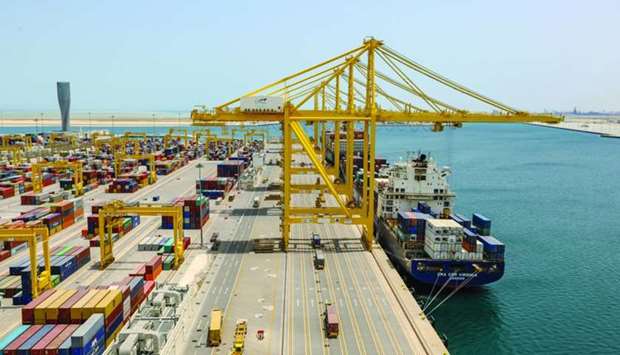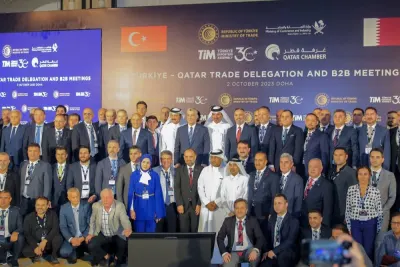Qatar's share in the overall Middle East trade is expected to significantly increase with the robust technological infrastructure supporting the Hamad Port's second container terminal (CT2).
"The fully automated terminal is equipped with the latest technology and equipment that make the port operations faster and more efficient, enhancing productivity and maximising Qatar's share of Middle East trade," Mwani Qatar said in a tweet.
HE the Prime Minister and Interior Minister Sheikh Khalid bin Khalifa bin Abdulaziz al-Thani had in December 2020 inaugurated the initial operations of the CT2, which is poised to enhance the country’s competitiveness.
The 403,500 sqm CT2 development project comprises four phases. Full operation of Phases 1 and 2 will start before the end of 2022; while Phases 3 and 4 will be developed later to raise the port’s operational capacity according to local market’s needs.
Considering the sustained growth outlook of Qatar, both CT2 and CT1 are expected to give a big push to the domestic economy in the medium to long term, industry insiders said, highlighting that the port’s throughput is estimated to be roughly 1.5 times the gross domestic product or GDP.
The government's plan is to transform Qatar into a vibrant regional trading hub in the region, given its geographical proximity with the continents and the attractive regulatory and legal environment as well as robust infrastructure.
Sources in the port and logistics sectors are of the view that the Hamad Port has large potential for transshipment, which has already started attracting the leading global shipping giants towards Doha.
In 2019, Mwani Qatar and Swiss-based Mediterranean Shipping Company (MSC) had entered into a pact that will see Hamad Port become a regional hub for the Swiss company’s trans-shipment business.
The agreement will help in attracting more trans-shipment containers and encourage more international shipping lines to add Hamad Port to their regional routes and sign similar agreements in the future.
Hamad Port will handle some 100,000 TEUs (twenty foot equivalent units) per year for MSC from 2020, with capacity growing to 1mn TEUs, which will be one-third of the CT2's overall capacity.
The MSC will use the port to load and unload containers, re-exporting contents destined for other ports in the region.
“The agreement contributes to the optimal utilisation of the capabilities of Hamad Port and will enhance the import and export operations through it,” Abdulla al-Khanji, Mwani Qatar, had said at the signing of the agreement.
Hamad Port’s strategic geographical location offers opportunities to create cargo movement towards the upper Gulf, supporting countries such as Kuwait and Iraq, and south towards Oman, QTerminals chief executive Neville Bissett had said.
"The fully automated terminal is equipped with the latest technology and equipment that make the port operations faster and more efficient, enhancing productivity and maximising Qatar's share of Middle East trade," Mwani Qatar said in a tweet.
HE the Prime Minister and Interior Minister Sheikh Khalid bin Khalifa bin Abdulaziz al-Thani had in December 2020 inaugurated the initial operations of the CT2, which is poised to enhance the country’s competitiveness.
The 403,500 sqm CT2 development project comprises four phases. Full operation of Phases 1 and 2 will start before the end of 2022; while Phases 3 and 4 will be developed later to raise the port’s operational capacity according to local market’s needs.
Considering the sustained growth outlook of Qatar, both CT2 and CT1 are expected to give a big push to the domestic economy in the medium to long term, industry insiders said, highlighting that the port’s throughput is estimated to be roughly 1.5 times the gross domestic product or GDP.
The government's plan is to transform Qatar into a vibrant regional trading hub in the region, given its geographical proximity with the continents and the attractive regulatory and legal environment as well as robust infrastructure.
Sources in the port and logistics sectors are of the view that the Hamad Port has large potential for transshipment, which has already started attracting the leading global shipping giants towards Doha.
In 2019, Mwani Qatar and Swiss-based Mediterranean Shipping Company (MSC) had entered into a pact that will see Hamad Port become a regional hub for the Swiss company’s trans-shipment business.
The agreement will help in attracting more trans-shipment containers and encourage more international shipping lines to add Hamad Port to their regional routes and sign similar agreements in the future.
Hamad Port will handle some 100,000 TEUs (twenty foot equivalent units) per year for MSC from 2020, with capacity growing to 1mn TEUs, which will be one-third of the CT2's overall capacity.
The MSC will use the port to load and unload containers, re-exporting contents destined for other ports in the region.
“The agreement contributes to the optimal utilisation of the capabilities of Hamad Port and will enhance the import and export operations through it,” Abdulla al-Khanji, Mwani Qatar, had said at the signing of the agreement.
Hamad Port’s strategic geographical location offers opportunities to create cargo movement towards the upper Gulf, supporting countries such as Kuwait and Iraq, and south towards Oman, QTerminals chief executive Neville Bissett had said.




